By Richard A. Miech, Lloyd D. Johnston, Megan E. Patrick, Patrick M. O'Malley, Jerald G. Bachman and John E. Schulenberg
Substance use is a leading cause of preventable morbidity and mortality; it is in large part why, among 17 high income nations, people in the U.S. have the highest probability of dying by age 50. Substance use is also an important contributor to many social ills including domestic violence, violence more generally, theft, suicide, and more—and it typically is initiated during adolescence. It warrants our sustained attention. Monitoring the Future (MTF) is designed to give such attention to substance use among the nation’s youth and adults. It is an investigator-initiated study that originated with, and is conducted by, a team of research professors at the University of Michigan’s Institute for Social Research. Since its onset in 1975, MTF has been funded continuously by the National Institute on Drug Abuse—one of the National Institutes of Health—under a series of peer reviewed, competitive research grants. The 2022 survey, reported here, is the 48 th consecutive national survey of 12th grade students and the 32 nd national survey of 8 th and 10th grade students (who were added to the study in 1991). …
Ann Arbor, MI: Institute for Social Research, University of Michigan. 2023; 523p.








